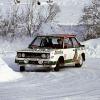(part of the article only, click the link above to read all)
Well, this is the way it normally works, however there is another aspect of the starting procedure that drivers don't have a say in and that is the official ‘jump start system'. This system helps officials determine if a driver has jumped the start and is situated under the surface of the track. Incorporated into the lights sequence that allows the drivers to get the race underway, the system is activated as soon as the lights go on, sending a basic pulse type carrier frequency signal to race control.
Jenson Button
If a car moves whilst the system is activated the signal is automatically cut and race control knows which car moved and when. As soon as the lights go out, the signal is deactivated and cars are free to leave the grid. Therefore, so long as a car doesn't move before the lights go out, the system has no idea how quick they actually leave the grid.
Now, according to an inside source, Benetton have integrated the two systems. Each individual grid slot has it's own frequency, which can be picked up by any type of multi band receiver and Benetton then program this information into their launch control. When the lights go out, the car is automatically launched off the grid without the driver even needing to focus on the lights. By doing this, they have cut human reaction time down from about a quarter of a second to a millisecond, hence both Benetton's getting off to an absolute flying start from the Suzuka grid.
BAR actually knew of this system and tried to incorporate in at the American Grand Prix, however it failed to work correctly, testing time left in the season down to a bare minimum by the time they actually realized what Benetton were doing. The ingenious system, at the time, was perfectly legal however, according to the new regulations for the 2002 season, any form of this has now been banned.
Regulation 8.2: START SYSTEMS.
Any system, the purpose and/or, the effect of which is to detect when a race start signal is given, is not permitted.





























